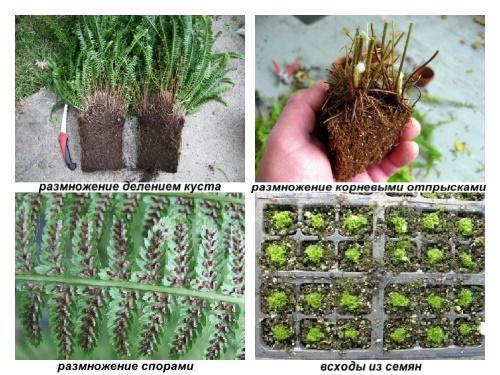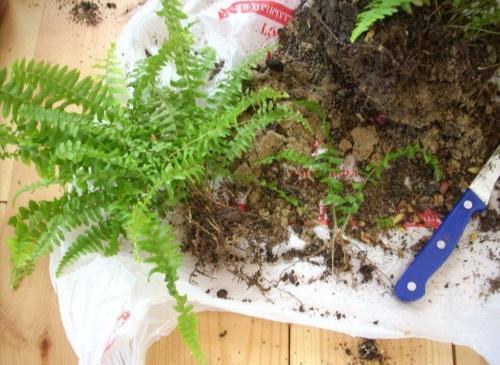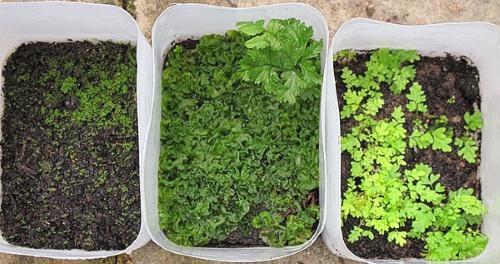How ferns breed: four ways to get a new plant
 If you want to turn your home into a cozy green oasis but don't want to mess with flowers, plant a fern. This beautiful plant with brightly colored feathery leaves and lush forms does not require special care. Humid air, diffused lighting, frequent spraying, and moderate watering - that's all it needs. In such conditions, the bush grows quickly, and you can make yourself a whole greenhouse. As you know, ferns bloom only in folk legends and fairy tales. However, this fact does not prevent them from having offspring in any way. How ferns breed, it is worth knowing for flower growers who have these plants in their flower economy.
If you want to turn your home into a cozy green oasis but don't want to mess with flowers, plant a fern. This beautiful plant with brightly colored feathery leaves and lush forms does not require special care. Humid air, diffused lighting, frequent spraying, and moderate watering - that's all it needs. In such conditions, the bush grows quickly, and you can make yourself a whole greenhouse. As you know, ferns bloom only in folk legends and fairy tales. However, this fact does not prevent them from having offspring in any way. How ferns breed, it is worth knowing for flower growers who have these plants in their flower economy.
Fern breeding methods
There are several methods by which new plant specimens can be obtained, namely:
- dividing the bush;
- disputes;
- side shoots;
- brood (lateral) buds.
Which one to use depends on the type of fern.
How and when to divide the bush?

Ferns tolerate spring division better and easier. You can also transplant and propagate plants at the end of August.
How do spore ferns reproduce?
 Ferns' spores serve as a kind of seed substitute. They are formed on the back of the leaves. On the wrong side of the frond there are small sacs - sori, in which sporangia with spores are located. When they are ripe, the sori should be cut with a piece of frond. They are stored in tightly closed paper bags until sowing. Fern spores are very small, powder-like. They fly away easily from the slightest breath of wind and even breath.
Ferns' spores serve as a kind of seed substitute. They are formed on the back of the leaves. On the wrong side of the frond there are small sacs - sori, in which sporangia with spores are located. When they are ripe, the sori should be cut with a piece of frond. They are stored in tightly closed paper bags until sowing. Fern spores are very small, powder-like. They fly away easily from the slightest breath of wind and even breath.
It is possible to determine whether the "seeds" are ripe by the color of the sori - they turn brown.
Spores should be sown in a shallow container with a thin layer of soil (up to 5 cm thick). It is better to use a sandy-peat soil mixture or a substrate for violets. Spores must be sown directly on top of the moistened ground and not sprinkled. Cover the container with glass. When green moss appears on the surface of the soil, this will be the germinated spores. They still do not have roots, and seedlings receive nutrition through rhizoids (hairs with which spores have germinated). After two months from the moment of sowing, roots and leaves begin to form. It is better to grow seedlings in an aquarium where the humidity level is high. Over time, it dives into the pots.
How to root side shoots?
 Most fern species produce scions. They grow on leaves and look like a long green arrow. To get a bush from a shoot, it must be rooted. To do this, place a container with nutrient soil next to it and fix the shoot in it.
Most fern species produce scions. They grow on leaves and look like a long green arrow. To get a bush from a shoot, it must be rooted. To do this, place a container with nutrient soil next to it and fix the shoot in it.
Within 1-2 months, the arrow will grow its roots. Then it can be cut off from the mother bush.
How to propagate a fern with brood buds?
 Some ferns have the ability to form lateral buds on the leaf stalks. This is how the onion-bearing bubblewort multiplies. Over time, the kidney grows roots. Then it is removed and placed in a glass container with a lid. It should be warm and humid. When leaves appear on the bud, it will be possible to plant it in the ground.
Some ferns have the ability to form lateral buds on the leaf stalks. This is how the onion-bearing bubblewort multiplies. Over time, the kidney grows roots. Then it is removed and placed in a glass container with a lid. It should be warm and humid. When leaves appear on the bud, it will be possible to plant it in the ground.